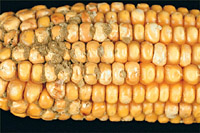A plant pathogen has entered the forests of California, and it is wreaking havoc on oaks and other species of trees. Over the past five years, oaks have been dying, and recently it appears that trees have been afflicted more quickly with what was termed sudden oak death syndrome. Since its discovery in Marin County, CA. in 1995, sudden oak death has disrupted wildlife habitat by causing the demise of tens of thousands of coast live oak, black oak, and tan oak trees. In 2000, the microorganism responsible for sudden oak death was identified as a Phytophthora sp., a cousin to the microorganism responsible for the Irish Potato Famine.
This Phytophthora sp. is now thought to infect at least 10 tree and plant species after the fungus was confirmed with DNA analysis in California buckeyes during the summer of 2001. It seems that everywhere scientists turn, they find the disease. The fungus is easily spread by spores that travel in wood, soil or rain splash, and it is moving rapidly through the forest. Once the spores have entered a tree, the fungus grows and produces enzymes that dissolve the dead outer and living inner layers of bark. A black ooze appears, signaling that the tree is under stress. The fungus then moves inward, weakening the tree. In this weakened state, trees are vulnerable to beetle attacks. The tree then appears to die suddenly after the vessels that transport food and water become blocked by the fungus.
The problem does not end with the death of the trees because the dead trees pose a dangerous situation to campers. Dead trees, sometimes called widow-makers, can easily fall without warning and threaten campers in the coastal forests. In fact, falling trees have become enough of a problem that the China Camp State Park closed all 30 campsites in fear that campers might be injured by the falling giants. The park was to remain closed through November as crews worked to remove diseased and dying trees. Park officials estimated that 80 trees would be removed before the campsites were reopened.
Campers and hikers also are being asked to do their part in preventing the spread of this disease when they visit the parks. They are being asked to clean tires, shoes and pet's paws before leaving the area to prevent spread of the fungus that infects the oaks. Also, wood and soil should not be transported out the area since they are infested by the fungus, so construction workers are being asked to clean the equipment to prevent the spread of the disease.
Only time and science hold the answer to the question of whether we are seeing another "American chestnut blight," a disease which essentially decimated the American chestnut forests in the eastern US. For more information about the Sudden Oak Death Syndrome check out the California Oak Mortality Task Force at either of these website addresses: www.suddenoakdeath.org/ or at http://www.cnr.berkeley.edu/comtf/.
 |
Views: Aspergillus ear rot of corn is caused by Aspergillus flavus and Aspergillus parasiticus. These fungi may colonize only a few kernels on each ear but the colonization is a cause for concern nevertheless because these fungi produce aflatoxin, a potent carcinogen. The disease is most sever in areas with high temperatures and drought. Click image for an enlarged view and more information
|
